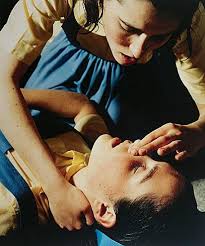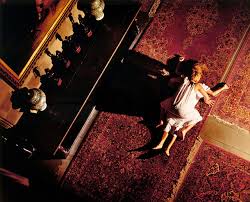How has stories and literature influenced the work of Anna Gaksell?
Traditionally, throughout the 20th century photography was centered around capturing the decisive moment, however, we have come to explore the notion of creating this ‘decisive moment’ artificially, constructing scenes made for only the purpose of photography. Tableaux photographs have been made from the beginning of the medium, although Staged photography emerged as its own known genre in the 1980’s; both ideas involve composing a scene much like a painting, creating elements of Pictorialism. Anna Gaskell creates ominous photographs of women, taking themes from literature and stories, generating a dream-like narrative in her work. I chose to look at Gaskell due to her staged and tableaux approaches and how she uses her influences to warp them into her own narratives and blurring the lines between fact and fiction. I am going to review the extent to which stories and literature has influenced her work using her imagery for Wonder (1996-97) influenced by Lewis Carroll’s Alice in Wonderland, and Hide(1998) influenced by Brother’s Grimm tale The Magic Donkey. In my own work I intent to explore the stories of the myths and folklore based in my home of Jersey. Using Gaskell as my influence to explore the notions of the boundaries of a narrative from a literacy influence in the visual work and representations. I plan to explore these notions with the narrative of the legends, through tableaux and landscape the reality of these stories and their occupation of the island.
Historical Context:
The movement that took the medium of photography and reinvented it into an art form is known to be Pictorialism. Pictorialists wanted to make the photographs look like painting and drawings to penetrate the art work, this eventually would happen and go on to juxtapose the original purpose of photographs. In 1839 photography was first used in order to objectively present subjects scientifically, images were highly scientific, fixing the point on objects, and was not considered an art form; that is until pictorialism was presented. The shift from photography being used to produce purely scientific and representational images happened from the 1850s when advocates such as the English painter Willian John Newton suggested that photography could also be artistic. Although it can be traced back to these early ideas, the Pictorialist movement was most active during the 1880s and 1915, during its peak it had an international reach with centers in England, France and the USA. Pictorialists were the first to begin to try and class photography as an art form, by doing so they spoke about the artistic value of photography as well as a debate surrounding the manipulation of photographs and the social role that eventually holds. Pictorialist photographers used a range of darkroom techniques that allow the photographers to express themselves creatively using it as a medium to tell stories.
Anna Gaskell:
Anna Gaskell is a contemporary American artist known for creating contemporary work exploring themes from literature and stories. Gaskell creates ominous images of women that nod to familiar or historic narratives, she explains her process of an attempt “to combine fiction, fact, and my own personal mishmash of life into something new is how I make my work.”, Gaskell is creating imagery by merging together reality, fiction and her own personal touches of the two warping and blurring the lines between the known stories and her own twist on them. Creating photographs that depict narratives from literature that may not be the original people know, Gaskell takes her influences and warps them into her own, stretching the boundaries of the narrative of the stories and literature that has influenced her work. Gaskell’s work dips into the notion of Pictorialism, using tableaux methods to generate her photographs. Gaskell’s photo series “Wonder” is influenced off Lewis Carroll’s Alice in Wonderland, the work is produced off the back of the idea of isolating dramatic moments from the larger plots. The photographs are staged and planned in the style of ‘narrative photography’, the scenes are artificial, produced and only exist to be photographed.
I have chosen to look closer at Untitled #47 from Anna Gaskell’s series Wonder, the photograph depicts two young girls both dressed identically interacting with each other with a sense of urgency, one towering over the other holding their neck and nose. Although interacting with each other they do not represent individuals, but instead, act out the contradictions and desires of a single psyche, Gaskell’s use of twins for the representation of Alice builds a connection and visual link of identicalness for in which we know they are being represented together rather than individually, while their unity is represented by their identical clothing and looks. Gaskell has staged the photographs to create her own striking visual reinterpretation of Wonderland through the moments of Alice’s physical transformation, the mysterious and often cruel rituals they act out upon each other may be metaphors for disorientation and mental illness. Gaskell’s work has no clear beginning or end containing ambiguous narratives, adding to the emphasis of the unknown and disorientation. This idea is striking in comparison to Alice in Wonderland as the narrative can be originally taken as Alice’s own dreams taken from stories, the character collectively evoked is Alice, perhaps lost in the Wonderland of her own mind, unable to determine whether the bizarre things happening to her are real or the result of her imagination. Gaskell has created a alternative narrative one in which the audience is familiar with, generating a post-modern effect of a simulacra to entice her audience.
In comparison to her series Wonderit is clear Gaskell has been influenced by other stories and pieces of literature which is clear to see in her later series Hide based off Brothers’ Grimm tale The Magic Donkey, this series has been suggested to be her most radical and abstract to date, the title of the series can be linked in reference to the children’s game ‘hide and seek’. In this series Gaskell has again cast young girls as her forefront protagonists, placing them in photographs that emit a sense of nightmarish foreboding and thinly veiled violence. Gaskell’s reference to the Brother’s Grimm story is brought out in the sense of anxiety that she creates with the dramatic lighting and camera angles.
WORD COUNT: 1,035
Bibliography
Readings:
- Martinique.E, (Nov 14 2016), WhenStagedPhotographyBecomesArt, Widewalls, https://www.widewalls.ch/staged-photography/
- Anna Gaskell, Artnet Worldwide Corparation, http://www.artnet.com/artists/anna-gaskell/
- The editors of Encyclopedia Britannica, Pictorialism Photography, Encyclopedia Britannica, https://www.britannica.com/technology/Pictorialism
- Pictorialism, The Art Story, https://www.theartstory.org/movement/pictorialism/
- Anna Gaskell,Guggengeim Museum , https://www.guggenheim.org/artwork/artist/anna-gaskell
- Women In the Arts(August 7, 2017) , Wonder and Whimsy: Anna Gaskell, National Museum of Women in the Arts https://blog.nmwa.org/2017/08/07/wonder-and-whimsy-anna-gaskell/\
- White Cube, https://whitecube.com/exhibitions/exhibition/anna_gaskell_duke_street_1999
Quotes:
- Anna Gaskell, Artnet Worldwide Corparation, http://www.artnet.com/artists/anna-gaskell/



Lillie, I have read your essay draft and have a few comments and corrections for you to make. So come and see me tomorrow Wed 29 Jan.
Mainly, I feel you need to read more about – esp paragraph 1: Historical context needs re-writing. I have attached a link to a chapter in David Bates’ ‘Art Photography’ that you need to read. It will provide you with a better understanding of tableaux photography and its link with Pictorialism. Try and identify a few quotes that you can use in the intro and in the paragraph about Gaskell’s work.
https://hautlieucreative.co.uk/photo17ase/wp-content/uploads/sites/21/2017/07/David_Bate_The_Pictorial_Turn.pdf
You also need to write a paragraph about how you explored tableaux approached in your responses to Jersey folk stories, Describe planning, recording, techniques and processes used in making your images.